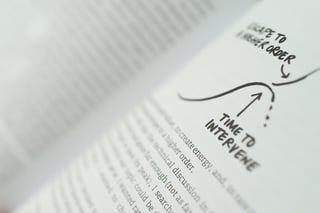
“This book is meant to be shared. Learned from. Scribbled in... and passed on to the next person advancing collaboration. So in the spirit of the book, I am giving away limited edition copies for FREE.... just sign up for our company's monthly updates and we will email you a link to download the book for free from Amazon” ~Brandon Klein - Co-Founder Collaboration.Ai
About the Book:
Learn from facilitation and strategy examples at Google, EY, Harvard, World Economic Forum, Genentech, The Arab League and many, many more.
Facilitation Elements
Successful facilitation comes from understanding the variables that will ensure the success of our event and knowing that these variables can be managed:

The Problem
We have invested several weeks understanding the problem to be solved or the solution to be designed. Most importantly, we have coached the sponsor team – the handful of leaders who visibly embody the need for the event and own its outcome – to understand where they are aligned or misaligned in understanding the problem. The problem has been shared with the participants prior to the event, though there is not likely to be consensus or even much understanding of its nature.
The Solution
A solution to the problem can exist. No one sees it yet (or perhaps everyone sees a different solution) but we are sure that the problem is not insoluble. Even more importantly, the sponsors have convinced me that they do not have a pre-cooked solution that they will spring on the participants after creating the illusion that this was a truly collaborative process.
The Participants
We’ve invited a good cross-section of participants, representing conflicting points-of-view, cutting across the hierarchy, with sufficient knowledge of how things work and don’t work. Everyone will contribute from beginning to end without interruption, particularly the sponsors.
The Inputs
All the information, analysis and other decision elements needed for the participants to do their work and take informed decisions have been assembled.
The Facilitation Team
We have the right mix of skills and characters to facilitate the client and sustain each other. We like each other and can have a laugh.
The Environment
We have sufficient space, light, fresh air, sustenance, access, furniture, equipment and flexibility to accommodate the type of work called for in each module.
The Facilitator's 6 Jobs
What is my role as a facilitator? As the name suggests, I am there to make things easy for others. As a facilitator, I have six jobs:
 Scoping
Scoping
Understanding what the client wants. Scoping an event involves clarifying what outcomes the client is seeking, how these outcomes will be put to use to achieve broader objectives, what decisions have already been taken, and what topics will not be addressed. (see Chapter 3)
Working with Sponsors
Building a trusting relationship with the sponsors about content. Event sponsors will only trust an outside facilitator to shape critical work with a large team if he or she invests the time and care to understand the business issue at hand and the personal and political challenges faced by sponsors. (see Chapter 4)
Preparation
Assembling the elements – some tangible, most not – that need to be in place in order to deliver an event. Logistics and knowledge inputs account for the bulk of the tangible preparation. The intangibles consist of deep learning about the client’s issues and the elements from which possible solutions will be constructed. (see Chapter 5) Of course, preparation includes agenda design, which is addressed separately in the subsequent chapter.
Designing
The process of building an agenda. I intentionally choose event modules and order them to achieve specific intermediate outcomes and to create a narrative of the event. The focus is on the process of involving clients in the design process rather than on the design per se. (see Chapter 6)
Delivery
Guiding a group of participants through designed work towards a desired outcome. This is what people tend to think of when I say facilitation: standing in front of a room full of people, moderating discussion, directing work, telling stories, listening, and generally waving my arms about in the hope of orchestrating the work of a group assembled for a common purpose. (see Chapter 7)
Value Capture
Helping sponsors employ event outcomes to achieve desired objectives. The critical period immediately following a facilitated event is as crucial as the event itself to helping the client achieve valuable results. (see Chapter 8)
Stories to Bring Collaboration to Life
In an event for the Arab League and their Arab Thought Foundation, they asked us to lead their annual gathering at their headquarters overlooking Tahrir Square in Cairo. At first we resisted. The League had remained largely unchanged for 70 years (it is older than the UN). Finally they said that many of the leaders would acknowledge that they had failed to achieve their goals in helping to create a better union of the 22 nations the League represents. We agreed to support them as long as they would let us train 55 local facilitators and 15 graphic scribes, half of whom were women, to lead the event. We had to create a design that was ‘emergent’ – one that left room for the unexpected – because there were so many elements which we simply could not control.
We knew Arabic countries had some of the most hierarchical structures on the planet, but the importance of emergent design was never so critical. The League has had countless Westerners come in and tell them what to do – all based on what has worked in the West, or how great democracy and the Internet are. We knew we couldn’t come in with a traditional design and continue to perpetuate the same agenda. So instead of teaching how to facilitate, we listened. We asked questions. Co-designing with the prince and the 55 young (25-35 year old) facilitators, we wrote breakthrough assignments. We challenged: if a Saudi Arabian leader wouldn’t listen to a young female facilitator in a break-out group, we would pair her with a man and instruct him not to speak. If they wanted to put a template on the wall to provide structure, we would let the facilitators and participants do it. Afterwards we would discuss the results. All 55 new facilitators agreed to avoid templates at all costs in the next round of work.
We focused on security and culture; youth and the social economy; development and finance. We intentionally didn’t solve anything. We were there to further open the conversation in the hope of achieving collaboration. We found ourselves on the news in most Arabic countries with photos of commoners and kings mingling in break-outs with young female facilitators. We facilitated discussions reportedly unheard of within the sacred halls...
During the design process, our job was to resist a linear, step-by-step design in favor of a more recursive design that could allow participants to discover unexpected linkages and insights. In the design itself, we built in as much variety as possible, both in terms of the topics discussed and in terms of the levels of recursion that these topics were viewed from. As facilitators, we tried to create the right physical and psychic spaces for such a discussion to occur. The physical space consisted of chairs in a circle, so that participants could see each other and so that what would otherwise have become a simulated discussion of individual comments and insights had the chairs been facing the same way, emerged as a genuine conversation. With the 55 facilitators, we ended up on the floor – arguing topics and ideas and ways we could lead the event together. The psychic space was created by ensuring that shy or low-status participants were encouraged to speak and by acknowledging their ideas and capturing them on white boards. Through body language and occasional repetition or re-phrasing, we maintained a high level of energy in the room, but otherwise we played no role whatsoever in ‘guiding’ the discussion; our job was simply to let it happen.
We can’t design for these fortuitous moments of emergence, and they don’t happen in every event. But we have to design every event and facilitate every debate in a way that increases the likelihood that such powerful discussions and such important insights will emerge.
About the Author - Brandon Klein
Brandon on LinkedIn & Twitter:
Better teams are fundamental to our success. In his recent book 'Facilitating Collaboration' Brandon combs through dozens of Fortune 100 companies where he has worked to share the best ways to succeed in the future of work.
Currently Brandon runs the software company Collaboration.Ai which is pioneering artificial intelligence and big data application in improving collaboration.
He has a diverse background:
- First Fortune 100 Chief Collaboration Officer serving over 200,000 employees to collaborate better
- Started a $2M venture funded company creating Europe’s largest natural health site later selling to Tesco PLC
- His documentary/film reached 75 million people. It challenged how charity/good intentions can do more harm than good (What are We Doing Here)
- Worked for several consulting companies, including EY on projects with 32 Fortune 100 companies as a consultant / facilitator / change leader
- His blog 4,000+ posts on excellence in collaboration Collaborationking.com
- Re-engineered education and community development through partnerships with Duke University & The World Economic Forum
Brandon has lived in Europe and Asia and currently resides with his wife and three children in Minneapolis.
